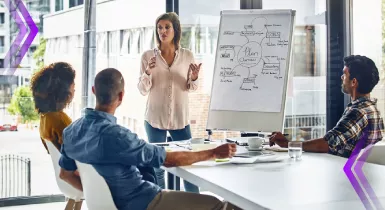Consider the scenario of initiating a new project. The first step you would take is to map out the project’s tasks and dependencies using a Work Breakdown Structure (WBS).
But what about other questions, such as Who will handle what tasks? How many resources are needed, and what are the associated costs?
This is where resource breakdown structure comes into the picture. It is a vital tool to visualize, plan, and organize resources effectively for the project.
Simply put, a resource breakdown structure (RBS) revolves around “breaking down” all types of resources required for each task, from the workforce to equipment, before project initiation.
This way, managers can allocate competent resources and ensure project activities or tasks are completed on time & within budget.
This blog explains what RBS stands for and how to create a perfect one using a resource management solution. Let’s begin:
What is resource breakdown structure (RBS)?
In project management, the resource breakdown structure (RBS) is a systematic list of resources required to execute a project. It is broken down by function and type and contains all resources on which project funds will be spent. It includes personnel, tools, machinery, materials, equipment, and software licenses.
A project manager is responsible for creating the resource breakdown structure during the project planning. They divide it into various tasks for different phases and estimate the resources required for the entire project lifecycle. They then distribute RBS to all stakeholders, team members, etc., to keep everyone on the same page and eliminate confusion around each resource’s roles and responsibilities.
Resource breakdown structure example in project management
For instance, an organization is launching new software and wants to create a marketing strategy to promote the product. Before starting, the project manager develops an RBS to ensure transparency regarding required project requirements. The manager will list the requirements, including the resources, the marketing collaterals (blogs, eBooks, social media posts, video scripts, emails, knowledge-based articles, etc.), the necessary tools, and timelines.
The human resources needed to start this project can be listed as follows:
- Three to four content writers to create the various materials
- Two content editors to review and approve the content
- Graphic designer to create illustrations for the guide, as well as the cover page
- Marketing manager to execute the marketing activities
- SEO specialist to conduct SEO-related activities
The tools required can include the following:
- Content management tools like Grammarly, keyword research tools, etc.
- Marketing tools
The timelines can be as follows:
- Content writers deliver the first draft
- The content editor reviews and edits
- Submission of the content draft to the SEO team
- The SEO specialist then submits the draft to the design team
- The designer creates illustrations
- The publisher compiles it
Now that we read the resource breakdown structure example, let’s understand the significance of resource breakdown structure in the project management realm.
Significance of resource breakdown structure
As discussed earlier, the role of RBS is to plan, identify, and help implement all available resources during a project’s development cycle. Given its flexibility, one can use resource breakdown structures in various industries, and drawing up one before working on a new project brings many benefits.
One of the significant benefits of using an RBS is that it helps identify and group resources to ensure competent allocation and efficient utilization throughout a project’s cycle.
Some benefits of a resource breakdown structure include the following:
Optimizes resource allocation
RBS provides a systematic breakdown of how to structure resources for various tasks in a project. This will enable managers to assign suitable project resources at the right time. Furthermore, RBS helps identify the required resources accurately by breaking down the project into smaller components. This ensures that resource allocations are based on precise requirements, avoiding overallocation or under allocation.
Moreover, the resource breakdown structure for projects enables managers to evaluate the availability of resources. They can identify potential constraints or shortages by mapping resource requirements against resource availability. This helps in planning resource allocation more effectively, considering factors such as resource availability, skills, certifications, and scheduling conflicts.
Enables effective project planning and scheduling
Resource breakdown structure helps organizations accurately create project plans and schedules by clearly defining the workforce required for each task. It allows managers to identify resource dependencies, critical paths, and bottlenecks and develop realistic timelines ensuring that project activities are appropriately structured, avoiding conflicts or resource shortages.
Furthermore, RBS enables organizations to estimate the quantity and quality of resources required for each task, making it easier for managers to assess the time, effort, and cost associated with each resource. In addition, the breakdown structure for projects enables managers to optimize schedules by adjusting task dependencies, reallocating resources, or redistributing workloads.
Read more: How to Perfect Resource Scheduling Techniques within Project Planning?
Ensures accurate cost estimation and budgeting
The resource breakdown structure, where the project is divided into various tasks, enables the project managers to estimate the costs associated with each task accurately. This helps develop total project budgets and facilitates cost control throughout the project lifecycle. Additionally, estimating the costs enables better financial planning, preventing cost overruns.
RBS provides a framework for tracking and controlling the project budget. By comparing the estimated costs with those incurred during project execution, managers can monitor the budgeted costs against the actual expenditure. These insights will enable managers to identify budget variances and take proactive measures to control and manage project costs effectively.
Facilitates efficient resource management and tracking
RBS enables effective resource management, allowing managers to track and monitor workforce utilization. Having a clear overview of resource assignments and availability, they can identify underutilized or overutilized resources and take appropriate actions, such as reallocating resources or adjusting timelines. This helps in optimizing resource usage and improving overall project efficiency.
Resource breakdown structure enables organizations to evaluate the performance and productivity of the resources efficiently. By tracking resource allocation, utilization, and actual performance, project managers can assess the efficiency and effectiveness of resources. This evaluation helps identify improvement areas, recognize high-performing resources, and make informed decisions for future projects.
Read more: 10 Reasons Why Resource Management is Crucial for a Business
Improves communication and coordination
The RBS facilitates effective communication and coordination among project team members, stakeholders, and external partners. It ensures that everyone clearly understands resource needs, availability, and potential conflicts. In addition, it enhances collaboration by enabling informed decision-making, resolving resource-related issues, and ensuring that everyone is aligned on resource allocation.
Furthermore, resource breakdown structure assists in coordinating cross-functional team workflow from start to finish. Moreover, it helps resolve conflicts related to workforce allocation and utilization. By having a clear breakdown of resources and their allocation, project managers can identify resourcing challenges or shortages in advance and communicate and coordinate proactively to resolve conflicts, either by reallocating resources, adjusting schedules, or seeking alternative solutions.
Helps identify and manage risks proactively
The RBS helps identify potential resource constraints and risks early in the project. Managers can proactively address resource-related risks and plan mitigating actions by assessing resource dependencies and availability. This reduces resource shortages or conflicts and improves project resilience.
Moreover, the resource breakdown structure for the project allows managers to develop risk response plans for resource-related issues. Additionally, managers can create contingency plans to address resource bottlenecks, such as identifying backup resources or alternative approaches.
Fosters better stakeholder management
The Resource Breakdown Structure (RBS) plays a crucial role in fostering better stakeholder management by offering transparency and visibility into resource allocation and usage throughout the project lifecycle. By clearly outlining the resources required for each task or activity, the RBS enables stakeholders to make informed decisions regarding resource allocation, budgeting, and project priorities.
This transparency builds trust and confidence in the project management process as stakeholders gain a comprehensive understanding of how resources are utilized and managed. Consequently, this leads to improved communication, alignment of objectives, and, ultimately, greater project success.
Facilitates efficient resource documentation
By documenting resource requirements, allocations, and usage in a structured manner, the RBS serves as a valuable reference for project documentation. This ensures that resource-related information is readily accessible and up to date.
This documentation plays a crucial role in supporting effective decision-making and project governance, as managers and stakeholders can rely on accurate and comprehensive resource data. Moreover, the RBS also serves as a knowledge repository or reference for future similar projects.
Now that we have understood the benefits let’s briefly compare WBS & RBS.
Work breakdown structure (WBS) vs. Resource breakdown structure (RBS)
Work breakdown structure is a detailed task description of any project. Through the WBS, the project manager categorizes the scope and deliverables into smaller, more manageable sections. RBS, on the other hand, is a document that encapsulates the list of resources needed to complete a project.
WBS is a visual representation of the total tasks and subtasks that each project team member should fulfill. On the contrary, RBS includes the details of all resources that cost money, such as personnel, equipment, supplies, licenses, etc. Other tools necessary for proper and efficient RBS include resource estimation, a resource calendar, and WBS.
Despite the differences, WBS and RBS are both interdependent and vital to ensure successful project delivery.
Read More: How to Create An Effective Project Plan in 9 Simple Steps?
Now that you know the difference between both terms, let’s review the challenges of resource breakdown structure.
Steps to effectively create a resource breakdown structure
Managers must meticulously follow specific disciplines to formulate a systematic, well-defined RBS. It can be described in a few steps given below:
Identify the project’s final deliverable & select a template
Before forming a project plan, a manager should be clear about client expectations and the final deliverable. The project’s objective can be anything from developing a new software functionality to building a missile. After defining the scope and deliverables, selecting a format for displaying RBS follows.
You can create a tree diagram, or spreadsheet or select a format based on the industry, organizational needs, stages, types of resources required, etc. There are also some pre-made templates available for each industry. Thus, after understanding the end goal and finalizing the template, one can define the project activities, resources, timelines, etc., to get a head start.
Enlist all tasks & activities at every project phase
The second step is creating a Work Breakdown Structure that divides the project into logical functions, phases, and tasks. Let’s take a simple, real-life example of a project to understand this better. For instance, the scope or objective of a marketing campaign project is to increase lead generation. Accordingly, the content manager (project manager in this case) will enlist all the tasks and subtasks by different phases of a marketing project.
Suppose the first phase is content creation, including tasks such as draft creation, editing, review work, & finalizing the content. The second phase is designing, covering tasks such as developing a campaign design (illustrations, videos, images, etc.). Finally, the project’s third phase tasks include setting up a marketing campaign, promoting the content, determining the target audience, choosing channels & running the ads.
Read More: What is Project Lifecycle and How to Get it Right?
Estimate & categorize resources for all project activities
Now that the details of all the task categories are defined, you can seamlessly identify resource demands regarding skills and numbers for every task. For example, the manager will first identify requirements for human resources- one content writer and copywriter for framing copies and blogs of the campaign, one content editor to review and approve the content, one graphic designer to create illustrations for the guide and cover page, and two marketing executives to target the right audience, and run the campaign.
Once you categorize the workforce, enlist the second resource type, non-human resources such as software and tools the team would need to complete the project. It includes work management software, a content management system, design tools like Adobe, etc., and social media marketing tools for campaign running.
Finalize & seek input from key project stakeholders
Another vital step before considering the RBS complete is to consult other executives, key stakeholders, or subject matter experts with relevant expertise and knowledge in the domain. It will help you make any updates or modifications to the RBS structure before implementation. It will also help get information about unwanted bottlenecks or potential risks ahead of the curve.
Lastly, a manager can include the resource breakdown structure with other essential documents like WBS, and scope documents and present them to key stakeholders. This will help the stakeholders understand the overall project and resource-based strategy and agree with the priorities.
Read More: Who are Project Stakeholders and How to Manage Them Efficiently?
Regularly review and update the RBS
Project environments are dynamic, and resource requirements may change over time due to factors such as shifting priorities, unforeseen risks, or evolving project scope. Therefore, it’s crucial to regularly review and update the RBS throughout the project lifecycle.
For example, if a critical task is added to the project scope, resources may need to be reallocated from less critical tasks to ensure the new task is completed on time. Thus, regularly reviewing the RBS allows project managers to identify these changes and make necessary adjustments.
Let’s now read how a modern ERM tool can help.
How can resource management solutions help you create a perfect RBS?
Forming an RBS takes you one step closer to seamless project resource management. To do it successfully, using a resource management tool is imperative. It gives you 360-degree visibility of all the resources across the organization. That way, in real-time, managers can filter out resources based on types, functions, skills, location, availability, experience, etc., and understand the gap even before the project initiates.
After forming the RBS, managers can effectively plan, manage, and utilize the resources using the tool. Its automated resource requisition workflow allows you to estimate and initiate resource requests beforehand and avoid last-minute firefighting.
Read More: Project Resource Management: An Ultimate Guide on How to Master it
Now, let’s read some additional tips that will help create a proper RBS.
Additional Tips to create an effective RBS
- Keep the RBS simple & logical: Streamline the Resource Breakdown Structure (RBS) by maintaining simplicity and logical categorization. A clear and straightforward RBS facilitates better understanding among project stakeholders, ensuring effective communication and streamlined resource management.
- Take an iterative approach: Embrace an iterative approach while refining the RBS. Regularly revisit and update the structure based on changing project dynamics and feedback. This flexibility ensures that the RBS aligns with evolving project needs and maintains relevance throughout the project lifecycle.
- Align RBS with work breakdown structure: Ensure coherence between the RBS and the Work Breakdown Structure (WBS). This coordination enhances project efficiency, fostering a seamless integration of resources and tasks. Furthermore, it helps identify resource interdependencies, contributing to a more synchronized and successful project delivery.
Conclusion
Framing a perfect resource breakdown structure can effectively transform how you execute projects within the organization. The steps mentioned above will help you organize, schedule, and manage project resources with ease. This, in turn, will ensure that you complete the project within the timeline and budget, leading to enhanced profitability and client satisfaction.
The Glossary
Read More: Glossary of Resource Workforce Planning, Scheduling and Management
The SAVIOM Solution
SAVIOM is the market leader in offering the most powerful and configurable solutions for managing enterprise resources efficiently and effectively. Having more than 20 years of experience, this Australian-based MNC has a global presence in over 50 countries. It is also popular with more than 100 customers and helps them achieve their business goals. SAVIOM also has products for project portfolio management, professional service automation, and workforce planning software which can be easily customized as per business requirements.












